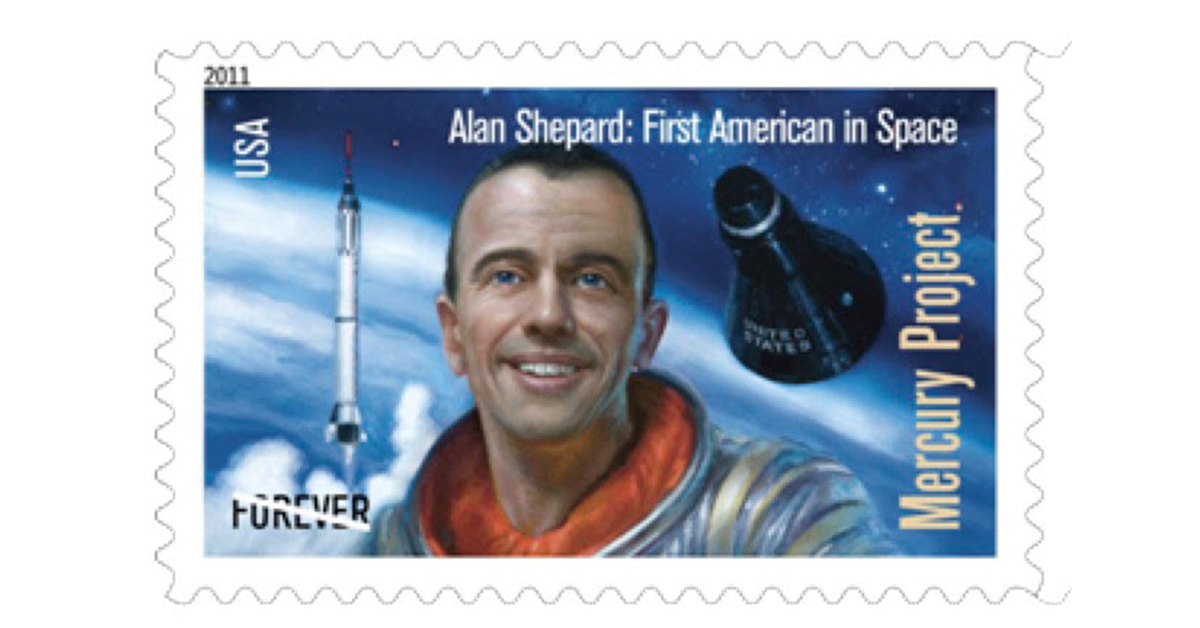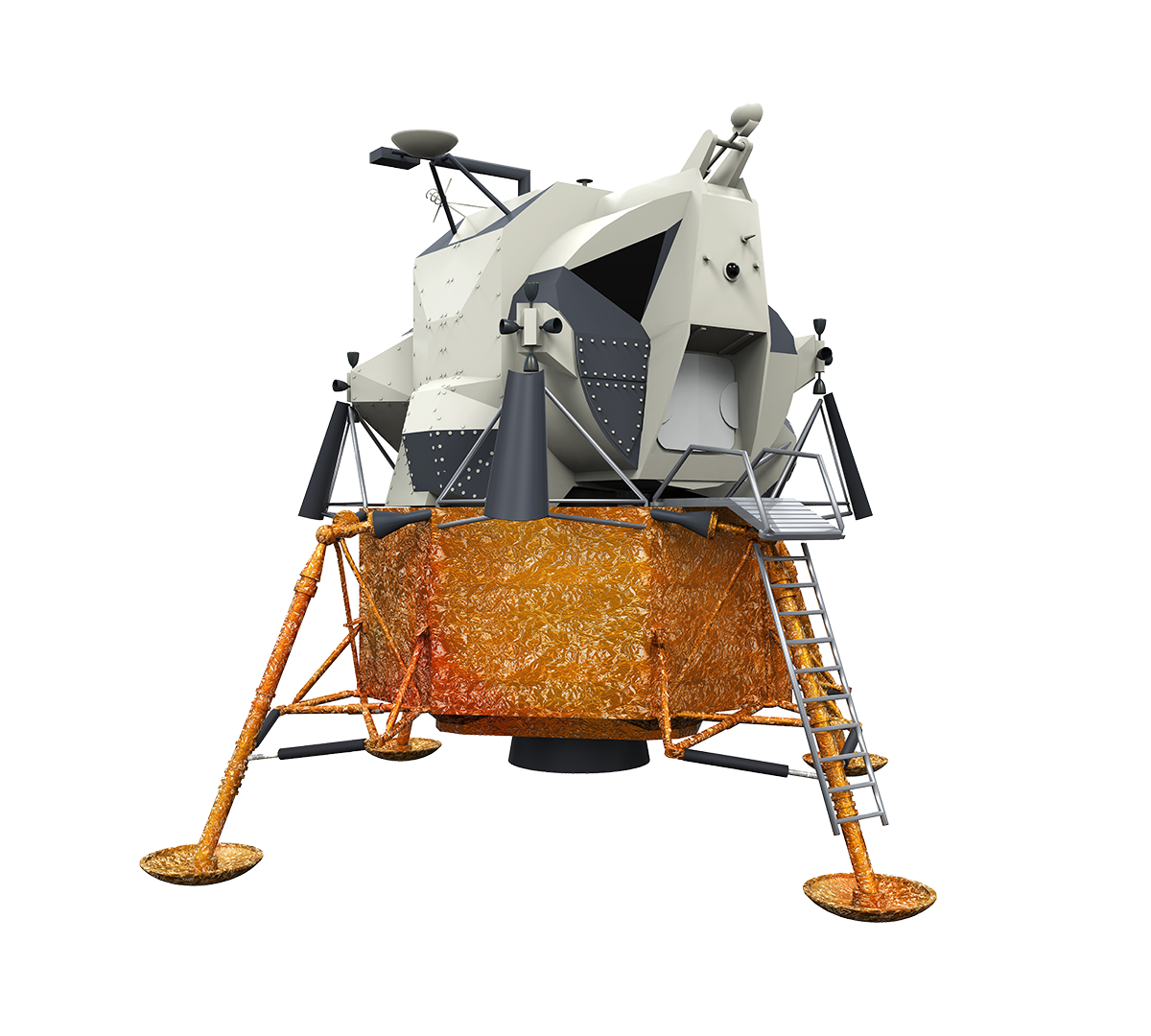Photo Credit: The United States Postal Service
For the past 10 days we’ve enjoyed counting down to the most important 15 minutes in the history of American space flight -- Alan Shepard’s short but monumental foray into space.
It was 9:34 am when Freedom 7 left the launch pad, destined to grace the stars. Shepard flew 116 miles, then parachuted to splashdown. Seemingly simple, this feat is the culmination of years of soul-crushing trial and error
Although Shepard is defined to a large degree by those 15 minutes, we’d like to focus this last day of the blog -- lift-off day -- on the other roughly 39 million minutes of the life of this American treasure.
The Man Behind The Helmet: Born Alan Bartlett Shepard, Jr. in 1923, Shepard graduated with a bachelor's degree from the U.S. Naval Academy in 1944. Upon graduating he married Louise Brewer, whom he had met while at school. Together they had three daughters: Julie, Laura, and Alice. His hobbies included writing, and investing, swimming, sailing and many other outdoor activities -- but more on that later.
Military Career: Following his graduation from the U.S. Naval Academy, Shepard deployed to the Pacific during World War II. Shepard then entered the naval flight training pipeline, earning his fighter pilot wings in 1947 and serving multiple tours of duty in the Mediterranean region. As a Navy test pilot and instructor, Shepard was involved in flight testing several naval aircraft, mid-air refueling trials and the testing of the Navy’s first angled aircraft carrier deck. According to his NASA biography, Shepard logged more than 8000 hours of flight time, including 3700 hours flying jets as a pilot.
A Devastating Grounding: In May 1961, Shepard was in training for the first two-man Gemini mission that would lead to Apollo astronauts circling and landing on the moon. He was in the running to fly these missions when an inner ear illness known as Meniere’s disease grounded him. This disease causes dizziness, vertigo, nausea, and lack of balance. For an astronaut, it is a devastating diagnosis. The condition is chronic, but not always incurable. For nearly six years Shepard was to work at the NASA astronaut office at a desk job, watching his colleagues fly missions that were supposed to be his. Shepard was not one to wait and watch opportunities pass him by, so he looked for a cure. When a new experimental procedure offered Shepard a 20 percent chance of getting his astronaut life back, he jumped at the opportunity...and it worked. He was cleared to fly the Apollo mission and soon walked on the moon.
After his first flight with Project Mercury, Shepard aimed his sights higher: To the Moon. NASA officials were hesitant to give Shepard, then 47, command of a moon mission. They were unsure of the impact age could have on an astronaut’s performance. Despite this, Shepard began a successful internal campaign to gain support. Originally meant to command the ill-fated Apollo 13 mission, he became the fifth and oldest man to walk on the Moon as commander of Apollo 14 in 1971. Age has become less of a barrier for astronauts since Shepard’s flight to the Moon. Astronaut John Glenn flew a mission at the age of 77 aboard Discovery in 1998.
FORE: The measure of a true hobbyist is that they will pursue it anywhere possible. Alan Shepard was no different. When Shepard found out that he was to be commander of Apollo 14, he took the opportunity to play golf. Not only was he the first American in space, but the first and only person to have played golf on the moon. Shepard had to get a custom made 6-iron head that would be able to fit on the end of a lunar sampling tool. At the end of a live broadcast to Earth, Shepard took out his makeshift iron and took a few practice swings. His first shot was weak, but he watched his second shot launch above the Moon’s surface and joked live on the broadcast that it traveled “miles and miles and miles.” In reality, it only traveled about 40 yards, but a solid effort considering the bulky spacesuit and makeshift club. The divots that Shepard made, as well as the golf balls, still remain on the Moon’s surface and can be seen from the satellite. The “golf club” can be viewed in person at the United State Golf Association Museum and Library in New Jersey.
For The Cause: In 1984, Shepard was among six Mercury 7 astronauts to form the Mercury 7 Foundation, later known as the Astronaut Foundation Scholarship (ASF). The foundation supports and encourages student innovators with STEM projects, and honors former astronauts. Astronauts from the Mercury, Gemini, Apollo, Skylab and Space Shuttle programs have joined in the mission to further the impact of ASF on today's youth. Known to be one of the largest monetary scholarships available to STEM undergraduate students, participants are nominated by their university professors. Since its creation, ASF has awarded over $4 million in scholarships to more than 400 students across the nation.
Pop Culture: Alan Shepard’s mission paved the way for the American space program. Shepard’s success also had a serious effect on the emergence of space in pop culture. For example, Shepard himself has been referenced or honored in multiple ways over the years. The opening credits of the 2003 series, Star Trek Enterprise, include live footage featuring the successes of American spaceflight. In this montage they include shots of Shepard, the Apollo 11 crew and the Space Shuttle Enterprise. On the 50th anniversary of his Freedom 7 Launch, the United States Postal Service honored Shepard by dedicating a stamp to his historic flight. In 2020 Disney+ released a series called “The Right Stuff,” which is an adaption of the Tom Wolfe nonfiction novel. The show follows the first group of astronauts and their lives while they prepare and train to join Project Mercury.
Authors – The entire ERAU Communications Class who has worked on the Countdown Blogs

